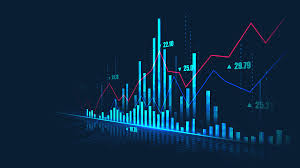
Introduction
The stock market is one of the most powerful forces in the global economy. It is where businesses raise capital, investors build wealth, and governments gauge economic health. Every day, billions of dollars’ worth of stocks change hands on exchanges such as the New York Stock Exchange (NYSE) and the NASDAQ index, making headlines in financial media and influencing decisions from Wall Street to Main Street.
Yet for all its importance, the stock market can also be confusing and volatile. Many investors wake up and check market news only to wonder: Why is the market down today? Why are stocks down today? Understanding these daily fluctuations requires looking at both the big picture and the short-term factors that drive supply and demand.
In this article, we will explore the history and structure of the stock market, examine key indices like the NASDAQ today, analyze reasons behind market swings, and review the latest stock news that investors follow. By the end, you’ll have a clearer picture not just of how the stock market works, but also of what makes stocks rise and fall in real time.

Part I: The Basics of the Stock Market
What Is the Stock Market?
At its core, the stock market is a system of exchanges where shares of publicly traded companies are bought and sold. Each stock represents a fractional ownership in a company, giving investors a claim on profits (dividends) and a right to vote on certain corporate matters.
The stock market has two major functions:
- Capital Raising: Companies issue shares to raise money for expansion, research, or operations.
- Wealth Creation: Investors buy stocks hoping their value will rise, allowing them to profit from appreciation or dividends.
The performance of the stock market is often seen as a proxy for the health of the broader economy. Rising markets suggest optimism, while falling markets raise the question: Why is the stock market down today?
Major U.S. Stock Exchanges
The United States is home to two of the world’s most influential exchanges:
- New York Stock Exchange (NYSE): The largest and oldest exchange, hosting many of the biggest blue-chip companies.
- NASDAQ: Known for technology and growth-oriented stocks, the NASDAQ index includes household names like Apple, Microsoft, Amazon, and Google.
When financial news outlets report on NASDAQ today, they are usually referring to the NASDAQ Composite index, which tracks thousands of companies listed on the exchange.

Types of Stocks
Stocks can be categorized in several ways:
- Common Stock: Offers ownership, voting rights, and dividends.
- Preferred Stock: Offers fixed dividends, with priority over common shareholders, but usually no voting rights.
- Growth Stocks: Companies reinvesting profits to expand rapidly, often in tech sectors (many on the NASDAQ).
- Value Stocks: Companies seen as undervalued relative to fundamentals.
- Blue-Chip Stocks: Established, stable companies with long-term reliability.
Investors choose from these depending on their goals—whether income, growth, or stability.
Part II: Understanding Market Indices
To track performance, investors rely on market indices—weighted averages of stock prices across categories.
The NASDAQ Index
The NASDAQ index is particularly significant. Unlike the Dow Jones Industrial Average (limited to 30 companies) or the S&P 500 (500 companies), the NASDAQ Composite tracks over 3,000 stocks. Because of its heavy weighting in technology and biotech, the NASDAQ is often seen as a barometer of innovation-driven growth.
When you hear “NASDAQ today is up 2%,” it signals investor optimism in tech and growth stocks. Conversely, when NASDAQ is down, the question arises: Why are stocks down today? Often, the answer lies in interest rate shifts, earnings reports, or geopolitical risks.
Other Major Indices
- Dow Jones Industrial Average (DJIA): 30 large companies, often called “blue chips.”
- S&P 500: 500 leading firms across sectors, widely considered the best measure of U.S. equities.
- Russell 2000: Small-cap companies, reflecting risk appetite for smaller businesses.
Each provides different insights, but together they capture the state of the stock market at large.

Part III: Why Does the Stock Market Go Up and Down?
Investors frequently ask: Why is the market down today? or Why is the stock market down today? The answers can vary by the hour, but the underlying drivers are usually a mix of economic fundamentals, market psychology, and external shocks.
Key Factors Influencing Stock Prices
- Economic Data: Reports on inflation, jobs, GDP growth, and consumer spending directly affect expectations for corporate profits.
- Corporate Earnings: If companies beat expectations, stocks rise. If they miss, stocks fall.
- Federal Reserve Policy: Interest rate changes ripple through the market. Higher rates often pressure the NASDAQ index since tech valuations are sensitive to borrowing costs.
- Geopolitical Events: Wars, trade disputes, or pandemics can spook investors and send markets lower.
- Market Sentiment: Fear and greed cycles drive volatility. Sometimes stocks fall simply because traders are nervous about what might happen.
“Why Is the Market Down Today?”
On any given day, headlines may point to a catalyst:
- A weak jobs report.
- A higher-than-expected inflation reading.
- A Federal Reserve statement about tightening monetary policy.
- Disappointing earnings from a major NASDAQ company like Apple or Tesla.
Each of these can ripple across exchanges, prompting headlines like “Stocks tumble—why is the market down today?”
“Why Are Stocks Down Today?”
This phrase is often used interchangeably with the above, but it can also refer to sector-specific weakness. For example:
- Energy stocks might be down due to falling oil prices.
- Bank stocks might drop on regulatory news.
- Tech stocks (driving the NASDAQ today) may slide if bond yields spike.
Thus, while the overall market may be flat, individual stock news often explains why certain industries or companies are struggling.

Part IV: The Role of Market News and Stock News
Every trading day, financial media produces a flood of market news and stock news. This information flow keeps investors updated on developments affecting their portfolios.
Types of Market News
- Economic Reports: Inflation, unemployment, consumer confidence.
- Policy Announcements: Federal Reserve interest rate changes, government budgets.
- Corporate Earnings: Quarterly profit updates drive stock volatility.
- Global Events: Natural disasters, elections, or conflicts.
Stock News
Individual company updates—new products, mergers, leadership changes—can cause dramatic swings in share prices. For example, a positive earnings surprise from Microsoft can lift the entire NASDAQ index, while a disappointing forecast from Amazon might drag NASDAQ today into the red.
Part V: Long-Term Investing vs. Daily Fluctuations
While many headlines focus on why is the stock market down today, long-term investors know that daily moves often matter less than long-term trends.
Benefits of Long-Term Investing
- Compounding returns build wealth steadily.
- Volatility smooths out over decades.
- Major indices like the NASDAQ index and S&P 500 have historically risen despite short-term downturns.
Short-Term Trading
Day traders and swing traders, however, thrive on short-term moves, following stock news minute by minute. For them, knowing why stocks are down today is crucial for making profitable trades.

Part VI: Current Themes in the Stock Market
As of 2025, several big-picture themes dominate market news:
- AI and Technology Stocks: Companies in the NASDAQ index are leading in artificial intelligence, cloud computing, and semiconductors.
- Inflation and Interest Rates: Central bank policy continues to weigh on valuations, especially growth stocks.
- Global Supply Chains: Shifts after the pandemic and geopolitical conflicts keep markets volatile.
- Energy Transition: Green energy companies, along with traditional oil giants, are in focus as the world shifts toward sustainability.
- Retail Investor Influence: Social media and commission-free apps have amplified retail trading’s role in stock news.
Part VII: Case Studies – Why Stocks Were Down on Key Days
To illustrate, let’s revisit some recent events where investors asked, “Why is the stock market down today?”
- Inflation Scare (2022): CPI data came in hotter than expected, pushing Treasury yields up and sending tech-heavy NASDAQ today down 4%.
- Banking Crisis (2023): Regional bank failures led to market selloffs as investors feared contagion.
- Tech Earnings Miss (2024): Weak guidance from Tesla and Amazon dragged down the NASDAQ index, leading to headlines about why stocks were down that day.
These episodes show how quickly sentiment shifts, making market news essential for understanding moves.
Part VIII: How to Follow the Market Today
Investors wanting to track NASDAQ today or other indices rely on:
- Financial News Websites: Bloomberg, CNBC, Reuters.
- Market Apps: Robinhood, Fidelity, E*TRADE.
- Economic Calendars: Tracking when inflation reports, Fed meetings, and earnings releases occur.
These resources help answer the daily question: Why is the market down today?

Part IX: Risks and Opportunities
The stock market always balances risks with opportunities.
Risks
- Market crashes or bear markets.
- Rising interest rates hurting valuations.
- Geopolitical instability.
- Overvaluation of trendy sectors.
Opportunities
- Long-term growth of technology and healthcare.
- Diversification across global markets.
- Dividend-paying stocks providing steady income.
- Dollar-cost averaging during downturns.
Conclusion
The stock market is dynamic, complex, and deeply intertwined with the global economy. Whether you are a casual observer, an active trader, or a long-term investor, you’ve likely asked questions like: Why is the stock market down today? Why are stocks down today? The answers lie in a blend of economic data, corporate performance, policy shifts, and investor psychology.
By following market news and stock news daily—especially focusing on the NASDAQ index and other benchmarks—you can better understand not just the immediate reasons behind market moves, but also the long-term forces shaping financial markets.
While short-term volatility often dominates headlines, the broader story of the stock market remains one of innovation, resilience, and wealth creation. The key is learning to distinguish between noise and signal—knowing when “NASDAQ today is down” is a temporary blip, and when it reflects deeper changes in the economy.
In the end, the stock market will always fluctuate, but informed investors can navigate it with perspective, patience, and prudence.


